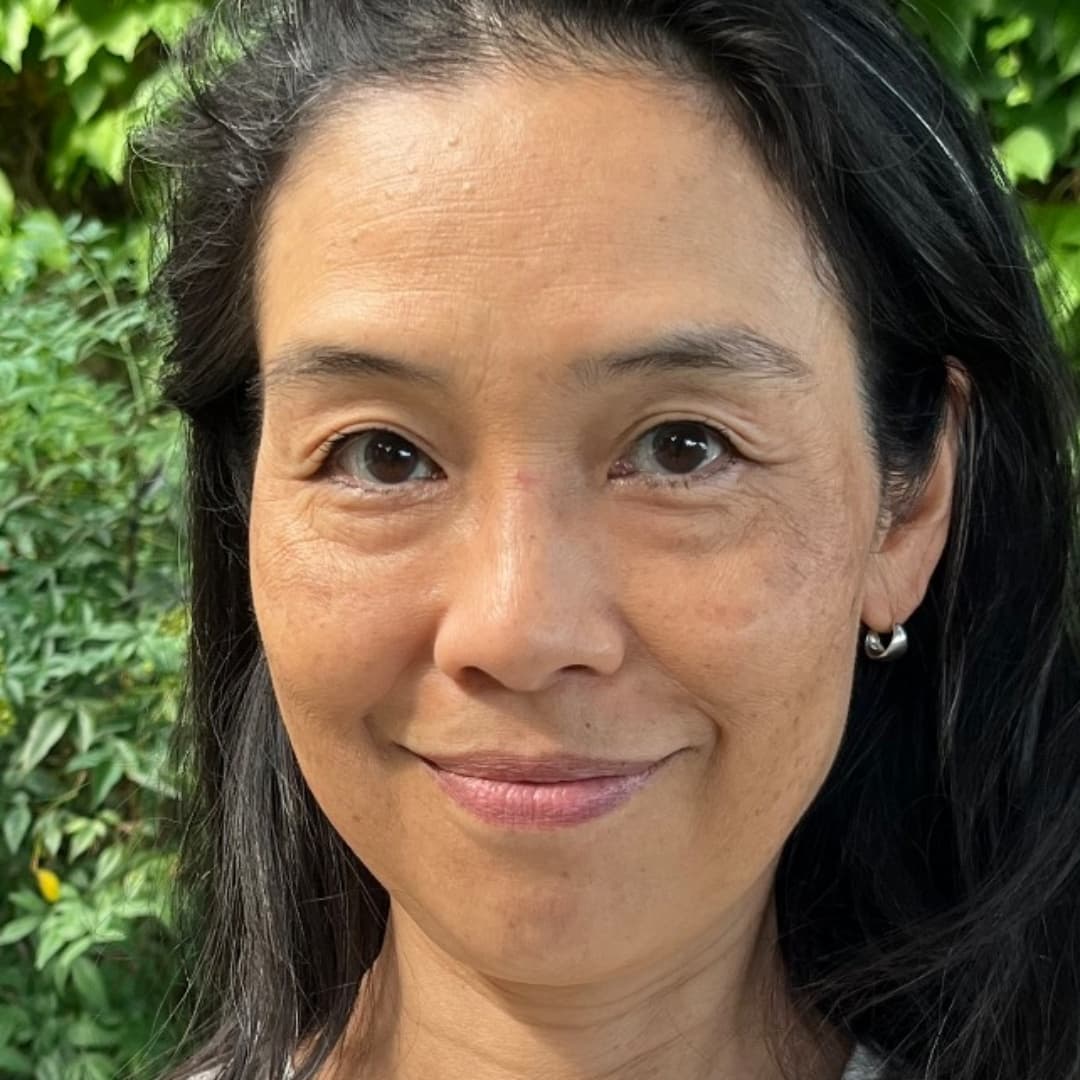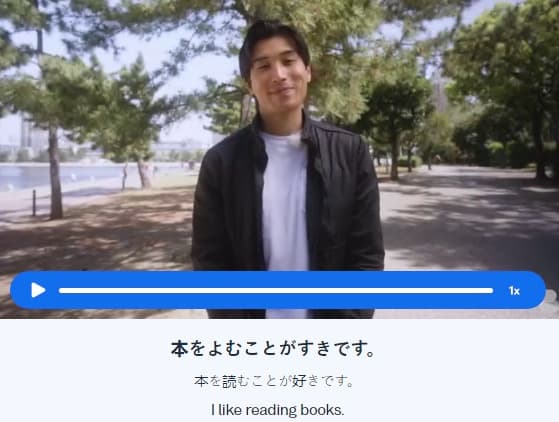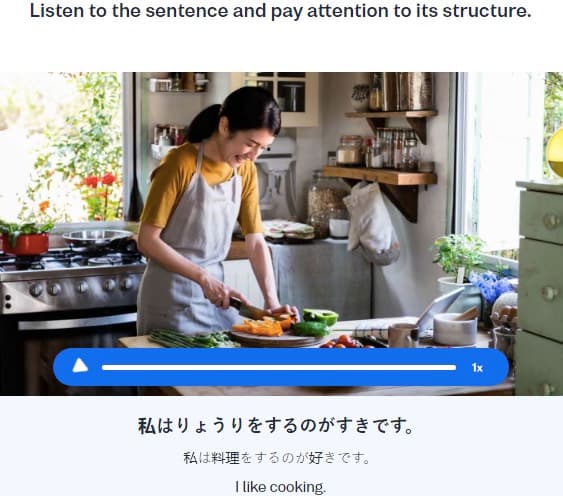I want to learn...
Knowing the characteristics of Japanese sentence structure is a key step in your journey to acquire this language. Needless to say, the Japanese language has a completely different structure from English and other western languages. Knowing certain sentence structures and characteristics is like having a map or compass to ensure you don’t lose your way.
In this guide you will see an overview of Japanese sentence structures. We’ll look at characteristics of Japanese sentences and phrases from the viewpoint of English speakers to help you understand how the sentence structure of each language is different.
By the end of this guide, you’ll be equipped with three very important rules for creating Japanese sentences. That means, of course, your journey of learning the Japanese language will become a more pleasant one!
Are you ready? Let’s get started!
Verb at the end of the sentence
One of the biggest adjustments you need to make when learning Japanese is the order of the subject, verb and object in a sentence. English and many other languages follow the SVO (subject + verb + object) sentence structure pattern.
Let’s have a look at a simple example in English:
I bought flowers.
(Subject + Verb + Object)
In this sentence, the subject ‘I’ comes first, followed by the verb ‘bought’ and ending with the object ‘flowers.’
In contrast to English, Japanese sentence structure often uses SOV (subject + object + verb) structure. The sentence “I bought flowers” becomes “I flowers bought” when using Japanese word order, as seen below:
わたしが はなを かいました watashi ga hana o kaimashita.( I ) ( flowers) (bought)
Note: In Japanese, the verbs always come at the end of the sentence!
As you might already know, there are many different sentence structure patterns in both Japanese and English. More often than not, we need to include much more information in a sentence – not all sentences consist of only one subject, one object and one verb.
So now let’s look at some sentences which include other information such as where or when something happens.
I bought flowers at the shop in front of the station yesterday.
⇓
わたし が きのう えきまえ で はな を かいましたWatashi ga kinō ekimae de hana o kaimashita.(I yesterday at the shop in front of the station flowers bought.)
As you may have noticed, the verb kaimashita is once again at the end of the sentence, because Japanese verbs always come at the end of the sentence!
As for all other information such as when, where, how, and so on, it is placed in between the subject and the verb.
This is the first step to getting used to Japanese sentence structures. Now let’s move on to the second point.
The particle: The most important element in the Japanese language
There is a grammatical element called the particle in the Japanese language which does not exist in English. Particles typically consist of one or two syllables and indicate the role of the previous word. You might say that particles are similar to English prepositions (words like ‘on,’ ‘in,’ ‘at,’ ‘with’ and ‘for’), but particles are placed after the word they refer to.
This is easier to understand with an example. Let’s see how particles are used in the example sentence we used earlier.
I bought flowers at the shop in front of the station yesterday.
⇓
わたし が きのう えきまえ で はな を かいましたWatashi ga kinō ekimae de hana o kaimashita. (I yesterday at the shop in front of the station flowers bought.)
The word watashi (わたし) means ‘I,’ kinō (きのう) means ‘yesterday,’ ekimae (えきまえ) means ‘in front of the station,’ hana (はな) means ‘flowers,’ and kaimashita (かいました) means ‘bought.’
Well, then how about the words ga (が), de (で) and o (を)?
Yes, these are particles! And they play a very important role within a sentence.
Let’s look at the function of each of these particles:
ga (が): subject marker
de (で): marks the place where the action occurs
o (を): object marker
When looking to understand a rather long sentence, we can divide the sentence into smaller segments. Here’s how:
Watashi ga → The noun ‘I’ is marked with subject marker ga (が), so we know this is the subject of the sentence.
kinō → This word for ‘yesterday’ does not need to be marked with a particle.
ekimae de → The word meaning ‘in front of the station’ is marked with de (で), so we know where the action occurred.
hana o → The word ‘flowers’ is marked with object marker o (を), so we know that it is the direct object of the action.
kaimashita → The final verb is always the main action taken by the subject.
By understanding particles, you’ll know what role a word plays in a sentence, as shown above. This is why mastering particles is extremely beneficial when learning Japanese. There are quite a number of particles that you should know. Some have only one meaning, while others have multiple functions, like ni (に) for example.
Example of a particle with multiple functions
The particle ni (に) is one example of a particle with more than one meaning, and it is a very common one that you will encounter at the beginning level.
Ni (に) can indicate:
The direction or destination, the place you are heading to or moving towards.
For example, nihon ni ikimasu (にほん に いきます) means “I will go to Japan.”The location of something or someone’s existence.
For example, ie ni imasu (いえ に います) means “I am at home.”The time, similar to the preposition ‘at’ in English.
For example, shichi-ji ni okimasu (しちじ に おきます) means “I get up at seven.”
So if there are multiple meanings to this one particle, how do you know which meaning is being used? You just have to understand the context to understand the intended meaning.
As you continue learning, you will find that particles are usually paired with certain verbs, and knowing this pairing can also help in your understanding. However, there is no rule or formula to this – it is just something you gain with experience. So as you keep learning, you will start to recognize these pairs.
It may feel overwhelming as you try to understand these grammatical elements. However, there is some good news – there are actually some common language elements and rules that do not exist at all in Japanese! Let's discuss those next.
Stress-free rules of Japanese sentence structure vs English
Luckily there are some rules that you do not have to worry about, as they do not exist in the Japanese language at all.
No articles or gender
Articles (words such as ‘a,’ ‘an’ and ‘the’ in English) simply do not exist in Japanese. There is no need to make these distinctions when introducing a noun. Additionally, unlike the Romance languages, there are no masculine, feminine or neutral nouns. One less thing to have to worry about!
No singular and plural nouns
Japanese nouns have no singular and plural forms. Hana (はな - flower) is always hana – it does not have a plural form and does not ever change. In the Japanese language, nouns are basically unchanging. If there is a need to show a particular quantity, it is done by adding a prefix or suffix to the original unchanged noun.
No future tense
There are only two primary tenses in Japanese sentences: past and present. For actions and states which have already happened or finished, we use past tense. For those that have yet to happen or finish, we apply present tense.
We also use the present tense for what can be identified as the ‘future tense.’ When expressing something that will happen in the future, you use the present tense.
You can tell the difference between past and future by using expressions which indicate time, such as ‘tomorrow’ or ‘next week,’ or words that indicate an intention or plan.
Verbs do take different forms in Japanese based on certain sentence patterns, and these are not that simple. But as far as tense is concerned, we can say that verbs are quite simple!
Practice with Japanese sentence structure examples
Just for fun, let’s have a go at making a sentence in Japanese. Try forming the following sentence in Japanese:
“I am going to have dinner with my family tomorrow.”
Don’t worry – you have all the vocabulary you need in the table below.
Words for Japanese sentence structure practice
| Rōmaji | Hiragana・Katakana | Meaning |
|---|---|---|
| ashita | あした | tomorrow |
| watashi | わたし | I |
| wa | は | particle to mark the topic |
| kazoku | かぞく | family |
| to | と | particle to mark accompaniment (similar to ‘with’) |
| resutoran | レストラン | restaurant |
| de | で | particle to mark the place where the action occurs (similar to ‘at’) |
| bangohan | ばんごはん | dinner |
| o | を | particle to mark the object |
| tabemasu | たべます | to eat |
Have you got your sentence structured?
Is your sentence the same as one of these below?
Ashita watashi wa kazoku to resutoran de ban gohan o tabemasu.
あした わたし は かぞく と レストラン で ばんごはん を たべます。Watashi wa ashita ban gohan o resutoran de kazoku to tabemasu.
わたし は あした ばんごはん を レストラン で かぞく と たべます。Watashi wa kazoku to ashita resutotan de bangohan o tabemasu.
わたし は かぞく と あした レストラン で ばんごはん を たべます。
It may be a bit of a shock, but …
… all of the sentences mentioned above are correct and mean exactly the same thing. This shows that word order is very flexible in Japanese sentences.
However, notice that the main verb is always found at the end of the sentence. The time-related words often come at the beginning. What makes the three sentences different is simply a matter of preference. The beginning of the sentence would most likely be what the speaker wishes to emphasize.
Furthermore, even if the sentences lack the subject or topic, watashi wa (わたし は – ‘I’), they are all still grammatically correct.
Ashita
watashi wakazoku to resutoran de ban gohan o tabemasu.
あしたわたしは かぞく と レストラン で ばんごはん を たべます。Watashi wa ashita ban gohan o resutoran de kazoku to tabemasu.
わたし はあした ばんごはん を レストラン で かぞく と たべます。Watashi wa kazoku to ashita resutotan de bangohan o tabemasu.
わたし はかぞく と あした レストラン で ばんごはん を たべます。
These sentences are not only grammatically correct but also sound very natural. In Japanese sentences, there is a tendency to omit information which is obvious from contextual clues. It may be hard to imagine for English speakers, but sentences without a subject or topic are quite common as well.
How can we be so flexible with the order of the words in the sentence, and how can sentences without a subject or topic exist?
Well, it's all thanks to the particle! Since each word is marked with a particle, the order isn’t that important. As long as you ensure that the word and its succeeding particle always move together, the segments of the sentence can be moved around and still produce the same meaning.
Now with this activity you’ve become familiar with the flexibility of word order in Japanese sentences and can understand the important role of the particle in Japanese sentence structure.
Wrapping up Japanese sentence structure
We’ve gone through three key aspects of the structure of Japanese sentences, plus one activity to show you the importance of the particles. Remembering the three elements provided in this guide allows you to have a good overall understanding of Japanese sentence structure.
As a reminder, here are the three points:
The verb goes at the end of the sentence.
Particles are important.
Know the stress-free rules – there are no articles, gender, plural nouns, or future tense.
Now you have learned the essential parts of how Japanese sentences are structured. Learning the language may take some time, but just keeping these points in mind will definitely help you in the future. Never stop learning!
Eager to improve your Japanese skills?
Why not take a free Japanese lesson with Busuu and learn the grammar and vocabulary you need to have real conversations? Level up with courses crafted by language experts, and get support and feedback from an active community of language learners and native Japanese speakers.
AUTHOR

Ayako Sasso
Newlanguages


